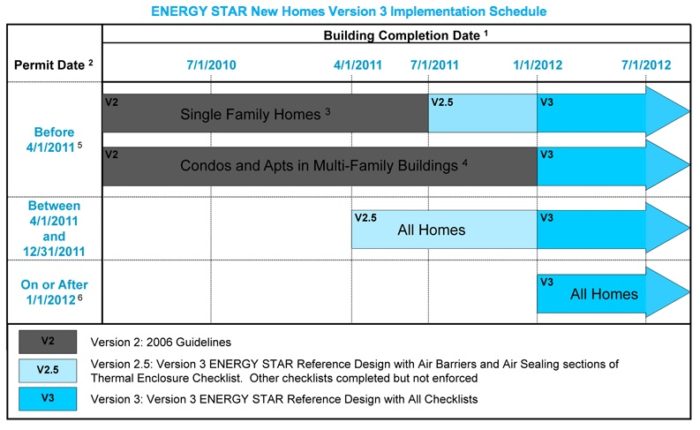
Although it was announced on December 1, the rescheduled launch of the Environmental Protection Agency’s Version 2.5 guidelines for the Energy Star for Homes program didn’t generate widespread coverage online. So we’ll look at some highlights here.
Originally set to take effect on January 1, 2010, the v2.5 guidelines are now scheduled for implementation on April 1. Single-family homes permitted before then are eligible to qualify for an Energy Star label under the current guidelines, Version 2, until July 1, 2011.
Note that the July 1, 2011, qualification deadline using v2 guidelines – aimed at new single-family homes that are at least 15% more energy efficient than comparable homes built to the 2004 International Residential Code – is the same as it was when the EPA announced the original implementation schedule for v2.5. All homes both permitted and completed between April 1 and December 31, 2011 (between January 1 and December 31, 2011, under the original schedule) must be qualified using the new, v2.5 guidelines, the EPA says.
The reconfigured implementation schedule also means that condos and apartments in multifamily buildings that are permitted before April 1, 2011, will be eligible for qualification under the current, v2 guidelines until January 1, 2012.
Version 3 still on track
One thing that doesn’t seem to have changed – at least not yet – is the EPA’s scheduled implementation, set for January 1, 2012, of the guidelines for Version 3. That will be the final stage of the progression, although v3 will be subject to periodic updates, based on program-partner input and evolving standards, with an appropriate adoption schedule for each update. (Click here for links to v2.5 and v3 program documents and scheduling details.)
The EPA also clarified a few key terms and issues: “Completion date,” for example, is the date of the final field inspection (not the Energy Star inspection) for the home; the Energy Star rater may define the “permit date” for a project as either the date that the permit was issued or the date of the contract on the home; and Energy Star uses the term “single-family homes” to include detached homes, townhouses, row houses, duplexes, and triplexes.
In addition, the EPA modified the treatment of basements as it relates to ”Benchmark Home Size” (a reference point based on average home sizes for a specified number of bedrooms) and the “Size Adjustment Factor” (a system for accommodating homes whose square footage deviates significantly from benchmark sizes) in both v2.5 and v3 of the guidelines: “Bedrooms and floor area in basements shall not be counted for the purpose of determining a home’s Benchmark Home Size and Size Adjustment Factor if at least half of the basement’s wall area is below grade.” The EPA also adds that, “as a result of this policy, a home has zero applicable bedrooms with regard to the Benchmark Home Size determination, then the Benchmark Home Size for one bedroom shall be used.”
To read an earlier report on changes to the Energy Star Homes specification, read Raising the Bar for Energy Star Homes.
Weekly Newsletter
Get building science and energy efficiency advice, plus special offers, in your inbox.














One Comment
It's gonna be interesting!
I've been writing about the new ENERGY STAR guidelines in our blog since they were first released last April and earlier this month released a white paper on the changes. Included in it are a summary of what's coming, what I think are going to be some of the hardest parts, and advice for the various stakeholders (builders, contractors, raters, & providers). Anyone who's interested can download this free white paper from:
http://bit.ly/hGyP1X
You can also see the articles I've written in our blog at http://blog.energyvanguard.com.
Log in or create an account to post a comment.
Sign up Log in